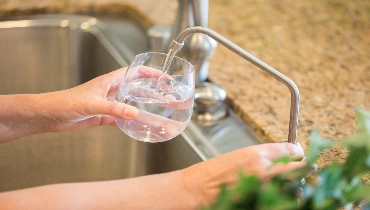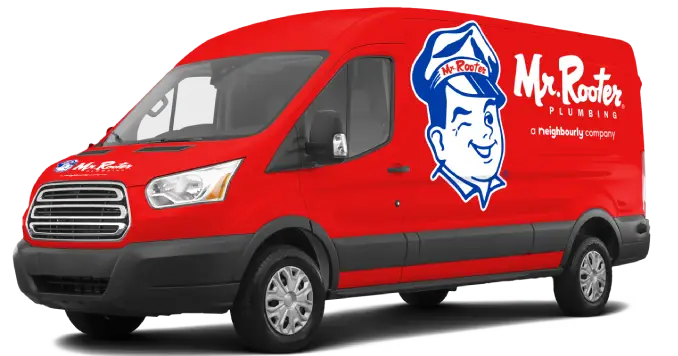
Does your water taste like bitter chalk, chlorine, and chemicals? Have you noticed any white chalky spots that remain on your dishware after you wash them? If you live in Alberta, you know how hard the unfiltered tap water can be.
Our hard water isn’t dangerous for your health and is much safer to drink than acidic water. Unfortunately, hard water can wreak havoc on your Edmonton plumbing system, and appliances, and simply tastes bad, especially with the chlorine in it.
The good news is you don’t have to suffer from this hard chlorine-treated water. Reverse osmosis water is filtered with a multi-step filtration process. This filtration removes harsh chemicals and impurities to make your water fresher, cleaner, and softer.
While reverse osmosis water isn’t a new technology, many people are unfamiliar with it. Depending on who you ask, you’ll find it offers many great benefits. Others may say you should skip it.
Are you wondering what in the world is reverse osmosis water? Here’s what you need to know and whether you could benefit from a reverse osmosis system.
What Exactly Is Reverse Osmosis Water?
A reverse osmosis system uses pressure to force unfiltered water through a series of filters and a semipermeable membrane. The membrane has tiny holes that catch and prevent contaminants from the water. The holes are large enough for water molecules to push through.
The side of the membrane with clean water is called the permeate. The other side of the layer consisting of the water with the contaminants is often called the brine.
With osmosis, water will pass through the membrane and become more concentrated to achieve equilibrium on both sides. Reverse osmosis is the opposite, making the water less concentrated and free from contaminants.
The entire reverse osmosis process is a little more complex but this is the general gist of it.
How Does Reverse Osmosis Work?
There are several filtering stages in the reverse osmosis system beyond the semipermeable membrane. Each part plays an important role in removing contaminants, achieving freshwater, and helping the reverse osmosis system to run smoothly.
The unfiltered water starts its journey by entering the pre-filter which removes sediment, solids, and particulates. From there, the water will go through a carbon filter which will remove chlorine and other chemicals that may affect the taste. Next, the water passes through the membrane and moves along to a carbon post-filter which will polish off any remaining contaminants before the water comes out of your faucet.
Reverse osmosis systems can have more than these three main stages. This depends on the number of pre and post-filters and your water filtering needs. Generally, with city water more stages of filtration are not required, however, with a well water source it may be beneficial.
After passing through the filters the clean reverse osmosis water sits in a holding tank waiting to be used. The standard installation includes a holding tank that will hold approximately one gallon of water. Depending on the household and the amount of usage, this may be enough or you may want more.
The System Stages
Many reverse osmosis systems will have 4 - 5 filtration stages, including the reverse osmosis membrane. The other filters include a sediment filter—also known as the pre-filter—and 2 carbon filters, one before the membrane and one after. The pre-filters come before the water passes through the membrane and the post-filters come after. If additional filtration stages are required, they will usually occur as a pre-filter.
The purpose of the sediment filter is to remove solid particles such as dust, rust, and dirt. While we rarely notice it there can sometimes be small amounts of sediment in the water, so this filter has a valid purpose.
For the second stage, the first carbon filter acts to remove chlorine and chemical additives in the water. Activated carbon is a very common filter medium and is very effective at removing these contaminants from water.
After pre-filtration, the water will enter the main filter: the semipermeable membrane. This is where the major action takes place as it removes most dissolved solids which ultimately reduces the amount of total dissolved solids or TDS to essentially zero. The system will apply pressure to the water to force it through the membrane.
After that, the filtered water will enter the storage tank(s) where it will stay until needed. Quality reverse osmosis systems will continue to filter water until the storage tanks are full and then automatically turn off. The water filters slowly because the membrane is so tight the water passes through at a very slow rate.
Lastly, you will control when the water passes through the post-filter which is another carbon filter. When you turn on a faucet, water from the storage tanks will pass through the carbon post-filter and out of the reverse osmosis faucet. This will remove any remaining contaminants like chlorine, volatile organic compounds or VOCs, and other contaminants that give your water an undesirable odor and taste.
The reverse osmosis water streaming from your faucet is clean and free of impurities.
The Purpose of the Storage Tanks
One item to note about reverse osmosis is that it’s a slow process. The average reverse osmosis system takes about a minute to produce two to three ounces of clean water. Without a storage tank, you can be waiting up to five minutes or more to fill something as simple as a glass of water!
Storage tanks help you have clean water readily available when you need it. When you turn on your faucet for a glass of water, there will be plenty of water for you to use.
Generally, reverse osmosis water isn’t used for utility purposes, only for consumption. Some people use it to cook with as well. However, if you wanted to use larger volumes of water there may be more appropriate solutions to meet your needs, depending on what you wanted.
Everything Reverse Osmosis Removes
The entire reverse osmosis system removes a range of contaminants as described above. Here’s a deeper look into the organic and inorganic substances a reverse osmosis system removes:
- Calcium
- Magnesium
- Sodium
- Chlorides
- Sulfates
- Arsenic
- Iron
- Lead
- VOCs
- Herbicides and pesticides
- Dissolved organic matter
Reverse osmosis water systems do a wonderful job of removing these contaminants. They don’t, however, remove bacteria and viruses. If you live in the city, most water treatment facilities will remove bacteria and viruses before the water comes to your home which is why there is chlorine in our water.
This filtration system may remove some bacteria but it will stick to and potentially grow along the membrane. You’ll need to replace the membrane to prevent any contamination. UV disinfection is an option you can add to remove more contaminants including bacteria and viruses.
Most TDS found in your water comes from a mix of natural sources, urban run-off, wastewater, and sewage. The plumbing system the water travels through may also add metals and minerals. Moreover, the water treatment process usually contributes to some chemicals as well. Removing these contaminants won’t only make your water taste and smell better but it will be healthier and safer to consume.
The Benefits of Reverse Osmosis Water
The major benefit of reverse osmosis water is that it’s free from potentially dangerous contaminants. This makes it much safer to drink and use. This clean water offers several other health benefits as well!
Health Benefits
Most water has traces of lead and other hazardous materials that can lead to potential health issues. A few health problems caused by lead found in hard water include high blood pressure, anemia, low fertility, and nerve damage.
Both children and adults can reduce their risk of developing anemic conditions and in some cases, brain damage. Reverse osmosis also removes parasites that could be carrying diseases.
People with pre-existing conditions and other ailments can also benefit from drinking reverse osmosis water. Those who are undergoing cancer treatments such as chemotherapy and radiation need clean drinking water.
Better for the Environment
Many people with municipal water can’t stand the taste and smell of their tap water. Without a reliable filtration system, many individuals and families will opt to purchase drinking water in the form of water bottles. This practice isn’t good for the environment and is an extra cost.
Adding a reverse osmosis system will make your water safe and delicious to drink right from the tap. It’s also one of the few water systems that use significantly less energy than other water filtration systems. Drinking fresh filtered tap water will reduce your plastic waste while also saving you money.
Good Tasting Water
If you have hard municipal water or have drunk municipal water before, you know how bad it can taste. It’s often bitter, chalky, and has a heavy chlorine odor. No one wants to drink water that tastes and smells like a swimming pool.
However, those who regularly drink hard water may find filtered or reverse osmosis water tastes different or “off.” Others prefer to have some mineral flavor in their drinking water.
When it comes to classifying water as “good tasting,” it can be rather subjective. Fortunately, most people who install a water filtration system are happy with the cleaner flavor of their water.
If you prefer some mineral taste to your water but only want the chlorine taste removed there are options for that as well. Luckily there are lots of different options available, just ask us, and we can help!
Where Can You Install a Reverse Osmosis System?
Where do you use a reverse osmosis system? Does it filter water for your whole home or just one place?
It’s rare to use a reverse osmosis system to filter your entire home as it’s unnecessary. Reverse osmosis systems work best for filtering small amounts of water as larger amounts will clog and wear down the membrane.
The only time you would filter your whole home with this type of filtration is if there’s a specific contaminant or the water quality is truly dire.
Most reverse osmosis systems work best in specific areas. The most common places you can install or connect a reverse osmosis system are:
- Under the kitchen sink
- The refrigerator
- At an office
- For some wells
You should note that reverse osmosis systems will work better in some places than others. Installing one under the sink will provide you with clean water for drinking and cooking. You can also connect this system to your refrigerator for drinking and making ice. Something that some people enjoy with a reverse osmosis system is having perfectly clear ice cubes! The clarity (or more so the lack of clarity) of the ice cubes is an easy reminder that it's time to change out your membrane!
While you can certainly add a reverse osmosis system to your RV or office, they will require slightly more maintenance. The challenge you may face with your RV is finding a drain as many campsites don’t always have drain hookups. Fortunately, this is a minor problem you can typically resolve with a spare bucket or a catch.
The Downside of Reverse Osmosis
Reverse osmosis offers many great benefits but there are a few drawbacks you should consider before investing in this type of water filtration system.
Reverse osmosis water doesn’t contain any minerals or metals making it demineralized. The filtration process removes both the bad and good minerals. For most people, this isn’t an issue as they can get plenty of healthy minerals from other sources.
Do you prefer to have some minerals and electrolytes in your water for hydration or other health needs? If yes, you may want to consider a different type of filtration system that doesn’t remove everything.
Another issue is that reverse osmosis systems do waste some water in the filtering process. The amount of wastewater depends on the system, some are more efficient than others.
You can, however, collect the wastewater and use it for other purposes. Some people will use it for cleaning or for watering plants.
Is Reverse Osmosis Right For You?
Reverse osmosis water is one of the purest types of filtered water. It’s free of all contaminants making it exceptionally safe to drink while also offering a great taste.
Do you struggle with hard chlorinated water in Edmonton? Contact our Edmonton plumbing team today to find the best water filtration system for your

